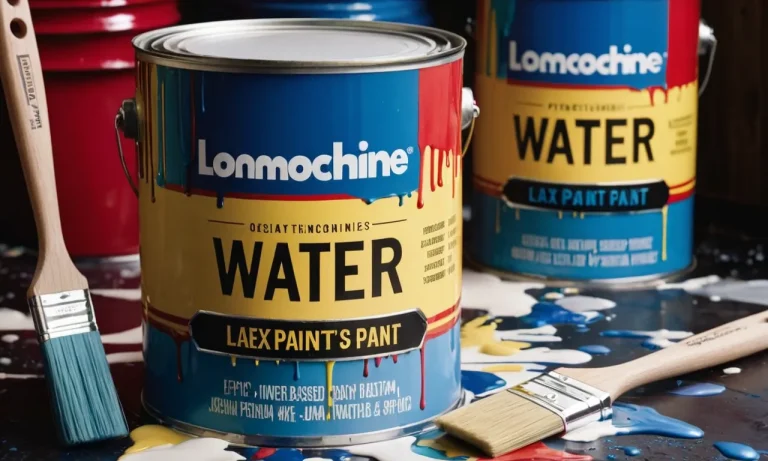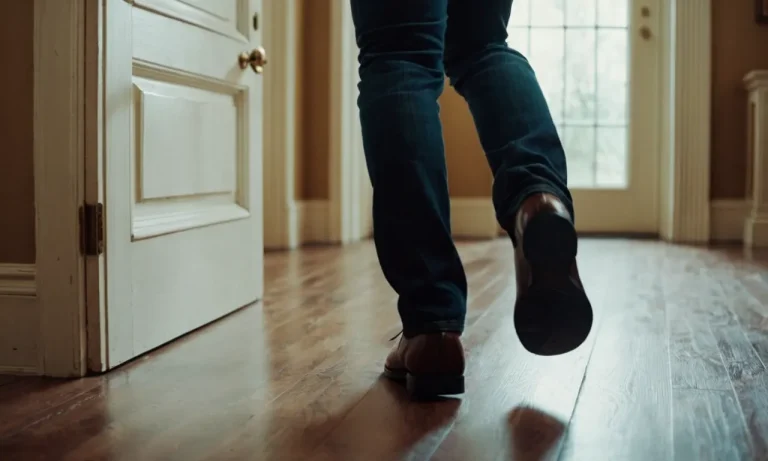Using Clear Coat Over Acrylic Paint For Protection And Enhanced Finish
For crafters and artists who use acrylic paint, applying a protective clear topcoat can be an important finishing step to help preserve the painted surface and enhance its appearance. In this comprehensive guide, we’ll look at everything you need to know about using clear coat over acrylic paint.
If you’re short on time, here’s a quick answer: Applying 1-2 thin coats of a clear acrylic sealant like polycrylic or varnish will help protect acrylic paint from damage, fading, and weathering over time. The clear coat also provides a uniform glossy or matte finish.
Benefits of Using Clear Coat on Acrylic Paint
Protection from Scratches, Smudges, Dust
One of the main benefits of using a clear coat over acrylic paint is the added protection it provides. The clear coat acts as a barrier between the paint and the outside world, offering a layer of defense against scratches, smudges, and dust.
This is particularly important for artwork or painted surfaces that are frequently touched or exposed to high traffic areas. The clear coat helps to preserve the integrity of the paint and keeps it looking fresh and vibrant for longer periods of time.
Prevents Fading from Sunlight Exposure
Another significant advantage of using a clear coat on acrylic paint is its ability to prevent fading caused by sunlight exposure. UV rays from the sun can cause the pigments in acrylic paint to break down and fade over time.
By applying a clear coat, you create an additional barrier that blocks harmful UV rays from directly reaching the paint surface. This helps to maintain the color intensity and vibrancy of the artwork or painted surface, ensuring it remains visually appealing for years to come.
Provides Uniform Finish – Glossy or Matte
Using a clear coat on acrylic paint also allows you to achieve a uniform finish, whether you prefer a glossy or matte look. The clear coat adds a layer of shine and depth to the paint, enhancing its overall appearance.
If you desire a glossy finish, you can choose a clear coat with a high gloss formula. On the other hand, if you prefer a more subtle, matte finish, you can opt for a clear coat with a matte formula. This versatility allows you to customize the final look of your artwork or painted surface to suit your personal taste and style.
How to Apply Clear Coat over Acrylic Paint
Let Paint Dry Completely First
Before applying a clear coat over acrylic paint, it is crucial to ensure that the paint has fully dried. This typically takes around 24 hours, but it is recommended to check the manufacturer’s instructions for the specific drying time of the paint you are using.
Applying the clear coat too soon may result in a wrinkled or uneven finish.
Lightly Sand Painted Surface
Once the paint has dried, it is important to lightly sand the painted surface before applying the clear coat. Sanding helps create a smooth and even surface, allowing the clear coat to adhere properly. Use a fine-grit sandpaper and gently sand the surface in a circular motion.
Be careful not to sand too aggressively, as it may damage the paint.
Dust Off Surface
After sanding, it is crucial to remove any dust or debris from the surface. Use a clean, dry cloth or a tack cloth to wipe away any particles. This step is essential to ensure a clean and flawless finish.
Apply Thin Coats of Clear Topcoat
When applying the clear coat, it is best to use thin coats instead of one thick coat. This allows for better control and minimizes the risk of drips or uneven coverage. Apply the clear coat in smooth and even strokes, following the natural contours of the surface.
Allow Proper Drying Between Coats
After applying the first coat of clear coat, it is important to allow it to dry completely before applying additional coats. This ensures that each coat adheres properly and reduces the risk of the clear coat becoming tacky or developing imperfections.
Remember, the key to achieving a professional-looking finish when applying a clear coat over acrylic paint is patience and attention to detail. By following these steps and taking your time, you can protect your acrylic artwork or painted surface and enhance its overall appearance.
Tips for Achieving Best Results
Use Short, Light Strokes
When applying clear coat over acrylic paint, it’s important to use short, light strokes. This technique helps to ensure an even application and minimizes the risk of streaks or brush marks. By using short strokes, you have better control over the amount of clear coat being applied, resulting in a smoother and more professional finish.
Work in a Dust-Free Space
Dust particles can easily ruin the final look of your clear coat. To avoid this, it is crucial to work in a dust-free space. Choose a well-ventilated area, away from open windows or doors where dust can easily enter.
You can also use a dust collector or air purifier to minimize the presence of airborne particles. Keeping your workspace clean and free from debris will greatly enhance the overall quality of your clear coat finish.
Consider Climate and Humidity
The climate and humidity levels in your area can have a significant impact on the drying time and effectiveness of clear coat. It’s important to take into consideration the climate and humidity conditions when applying clear coat over acrylic paint.
High humidity can cause the clear coat to take longer to dry, resulting in a longer waiting time between coats. On the other hand, low humidity can cause the clear coat to dry too quickly, leading to a less smooth and even finish.
Paying attention to the weather conditions and adjusting your application technique accordingly can help you achieve the best results.
Don’t Overbrush Clear Coat
When applying clear coat, it’s important not to overbrush. Overbrushing can cause the clear coat to become streaky and uneven. To avoid this, use gentle and even strokes, allowing the clear coat to self-level as much as possible.
Additionally, avoid going over an area that has already started to dry, as this can disturb the finish and create visible brush marks. Taking your time and being patient during the application process will help you achieve a flawless finish.
Choosing the Right Clear Coat Finish
Matte, Satin, or Gloss
When it comes to choosing the right clear coat finish for your acrylic paint, one of the first decisions you’ll need to make is whether you want a matte, satin, or gloss finish. Each of these options offers a different level of sheen and can greatly affect the overall look of your finished piece.
A matte finish has a low sheen and provides a subtle, non-reflective surface. It is perfect for those who prefer a more understated look or want to minimize any glare or reflections.
On the other hand, a satin finish offers a slightly higher sheen than matte, providing a smooth and velvety appearance. It strikes a balance between matte and gloss, making it a popular choice for many artists.
If you’re looking for a high-shine, reflective finish, then a gloss clear coat is the way to go. It adds depth and vibrancy to your acrylic paint, giving it a polished and professional appearance.
Acrylic, Polyurethane, or Lacquer
Another important consideration when choosing a clear coat finish is the type of product you want to use. There are various options available, including acrylic, polyurethane, and lacquer.
Acrylic clear coats are popular among artists because they are water-based, easy to use, and provide a durable protective layer. They are also non-yellowing, meaning that they won’t discolor your artwork over time.Polyurethane clear coats are known for their high level of durability and resistance to scratches and abrasions. They offer a strong protective layer and are commonly used on surfaces that require extra protection, such as furniture or floors.Lacquer clear coats provide a glossy and smooth finish. They are typically used in automotive applications but can also be used on artwork. Lacquer clear coats dry quickly and offer excellent clarity, enhancing the colors of your acrylic paint.
Spray vs Brush-On
When it comes to applying a clear coat finish, you have the option of using either a spray or a brush-on product. Each method has its own advantages and considerations.
Spray clear coats are popular because they provide an even and consistent application. They are also quick and easy to use, allowing for smooth and professional-looking results. However, they do require proper ventilation and can be challenging to control, so it’s important to practice and follow the instructions carefully.Brush-on clear coats offer more control and are ideal for small or intricate projects. They allow you to apply the clear coat precisely and evenly, giving you more control over the final result. However, brush-on clear coats may require multiple coats and can leave visible brush strokes if not applied carefully.
Remember, when choosing the right clear coat finish for your acrylic paint, consider the desired sheen, the type of product, and the application method. Experimenting with different options can help you achieve the perfect protection and enhanced finish for your artwork.
Clear Coat Options for Different Surfaces
Canvas
When it comes to protecting and enhancing acrylic paint on canvas, there are several clear coat options available. One popular choice is a gloss varnish, which provides a shiny and reflective finish. This can help to intensify the colors and make the artwork appear more vibrant.
Another option is a matte varnish, which has a non-reflective finish and can give the painting a more subtle and muted appearance. It is important to choose a varnish that is specifically designed for acrylic paint to ensure compatibility and optimal results.
For those looking to add texture to their artwork, there are also clear gel mediums available. These mediums can be applied over the acrylic paint to create different effects, such as a glossy or textured finish. They can also be mixed with paint to create custom textures and effects.
Wood
When applying a clear coat over acrylic paint on wood, it is important to choose a product that is suitable for both the paint and the wood surface. Polyurethane is a popular choice for protecting and enhancing acrylic paint on wood.
It provides a durable and long-lasting finish that can withstand wear and tear. Polyurethane is available in different finishes, including gloss, satin, and matte, allowing you to choose the desired level of sheen for your project.
Another option for protecting acrylic paint on wood is a clear wax. Wax provides a softer and more natural-looking finish compared to polyurethane. It can be applied with a cloth or brush and buffed to a smooth and glossy surface.
However, it is important to note that wax may need to be reapplied periodically to maintain its protective properties.
Metal
When it comes to protecting and enhancing acrylic paint on metal, there are a few clear coat options to consider. One popular choice is a clear enamel spray, which provides a protective and glossy finish.
Enamel sprays are easy to apply and dry quickly, making them a convenient option for metal surfaces.
Another option for protecting acrylic paint on metal is a clear lacquer. Lacquer provides a durable and long-lasting finish that can withstand exposure to the elements. It is available in different sheens, including gloss, satin, and matte, allowing you to choose the desired level of shine for your project.
Plastic
When it comes to protecting and enhancing acrylic paint on plastic, it is important to choose a clear coat that is specifically designed for this type of surface. One popular option is a clear acrylic sealer, which provides a protective and glossy finish.
Acrylic sealers are available in spray or brush-on formulas, making them easy to apply to plastic surfaces.
Another option for protecting acrylic paint on plastic is a clear epoxy resin. Epoxy resin provides a durable and high-gloss finish that can withstand exposure to the elements. It is important to follow the manufacturer’s instructions when working with epoxy resin, as it requires careful mixing and application.
Ceramic
When it comes to protecting and enhancing acrylic paint on ceramic surfaces, there are clear coat options available that can provide both protection and a glossy finish. One popular choice is a clear ceramic glaze, which can be applied over the acrylic paint and fired in a kiln to create a durable and glossy finish.
Another option for protecting acrylic paint on ceramic is a clear spray sealer. Spray sealers are easy to apply and can provide a protective and glossy finish. It is important to choose a sealer that is specifically designed for ceramic surfaces to ensure compatibility and optimal results.
It is important to note that when applying a clear coat over acrylic paint, it is recommended to test the product on a small, inconspicuous area first to ensure compatibility and desired results. Additionally, it is important to follow the manufacturer’s instructions for application and drying times to achieve the best possible finish.
For more information on clear coat options and techniques for protecting and enhancing acrylic paint on different surfaces, you can visit websites such as www.goldenpaints.com or www.dickblick.com.
Conclusion
Applying a clear acrylic sealant over dried acrylic paint can help provide long-lasting protection against damage while also creating a uniform, enhanced finish. With proper preparation and application techniques, a clear coat is an easy way to add durability and extra visual appeal to painted surfaces.
Just be sure to choose the right product for your particular project surface and needs.
We’ve covered the key benefits, application process, tips for best results, clear coat types, and usage on different surfaces when it comes to adding a protective topcoat over acrylic paint. Follow the recommendations in this guide and you can confidently seal and safeguard your artistic creations.







